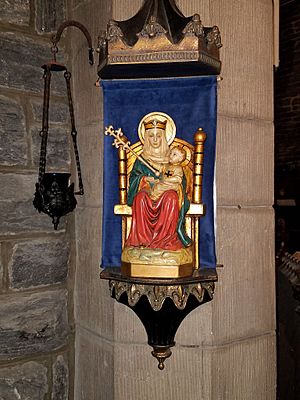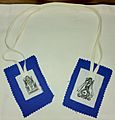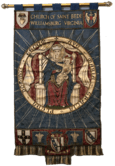Our Lady of Walsingham facts for kids
Quick facts for kids Our Lady of Walsingham |
|
|---|---|
 |
|
| Location | Walsingham, England |
| Date | 1061 |
| Witness | Richeldis de Faverches |
| Type | Marian apparition |
| Approval | Pope Leo XIII Pope Pius XII |
| Shrine | Basilica of Our Lady of Walsingham Anglican Shrine of Our Lady of Walsingham |
| Attributes | The Blessed Virgin Mary enthroned as Queen wearing a golden Saxon crown and golden slippers carrying the Child Jesus with the Gospel book and a Lily flower. |
| Feast day | 24 September |
Our Lady of Walsingham is a special name for the Virgin Mary. People from different Christian groups, like Catholics and Anglicans, honor her under this name. This tradition started in 1061 in the village of Walsingham in Norfolk, England.
It began when a kind English noblewoman named Richeldis de Faverches had visions of the Virgin Mary. Lady Richeldis then built a special house called "The Holy House" in Walsingham. This house later became a very important shrine and a place where many people traveled on pilgrimage.
After Richeldis, her son Geoffrey made sure the Holy House was cared for. He arranged for a priory (a type of monastery) to be built there. This priory was later looked after by a group of monks called the Canons Regular of St. Augustine.
Today, the feast day for Our Lady of Walsingham is celebrated on September 24th by both Anglican and Catholic churches. Anglicans also have another special day on October 15th. This day remembers when a statue of Our Lady of Walsingham was moved to the Anglican shrine in 1931.
Contents
History of Walsingham
The Vision of Richeldis
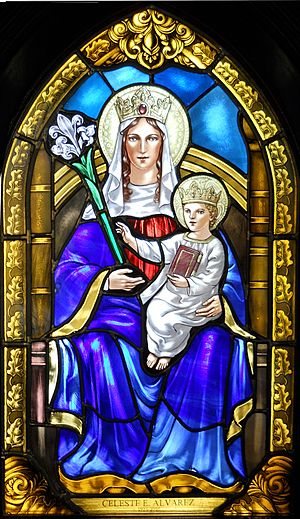
The story says that the Virgin Mary appeared to Lady Richeldis. During this vision, Richeldis felt like her soul was taken from England to Nazareth. There, she saw the house where the Holy Family (Jesus, Mary, and Joseph) once lived. She also saw where the Annunciation happened, which is when the Archangel Gabriel told Mary she would have Jesus.
Richeldis was then asked to build a copy of this house in her village in England. This building became known as the "Holy House." It quickly became a very important shrine and a popular place for people to visit on pilgrimage.
A modern wooden statue of Our Lady of Walsingham was made in Oberammergau, Germany. Over time, this special place became known as "Our Lady of Walsingham."
The Holy House and Pilgrimages
Some historians believe the chapel was built around 1053, during the time of King Edward the Confessor. They say Lady Richeldis was the founder. Later, her son Geoffrey gave the chapel to a clerk named Edwy. Edwy then helped to start a priory there.
However, another historian, Bill Flint, thinks the priory was founded in 1161. He suggests that Queen Edith the Fair might have been the one who had the vision in 1061.
By the 1500s, the shrine at Walsingham was one of the most important religious places in England and Europe. It was as famous as Glastonbury and Canterbury. Many people went on pilgrimages there during the Middle Ages. This was because traveling to Rome or Santiago de Compostela was very hard due to wars.
Kings and queens often visited the shrine. These included:
- King Henry III
- King Edward I
- King Edward II
- King Henry IV
- King Edward IV
- King Henry VII
- King Henry VIII
- Queen Catherine of Aragon
In 1513, a famous writer named Desiderius Erasmus visited. He wrote that the shrine was very beautiful, shining with "gems, gold and silver." He also described the statue of Our Lady as "a little image." Queen Catherine of Aragon was a regular visitor.
The Shrine's Destruction
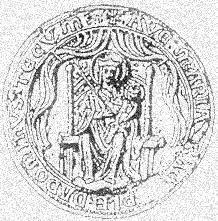
During the English Reformation, King Henry VIII decided to close down many monasteries. This was called the suppression of the monasteries. In 1538, the Walsingham priory was closed under the direction of Sir Roger Townshend.
The priory buildings were looted and mostly destroyed. However, people still remembered the shrine. Sir Roger Townshend wrote that some people still believed in miracles from the statue. He even had a woman punished for saying a miracle had happened. This shows how strong the belief in Our Lady of Walsingham was.
All that was left of the priory were the gatehouse, a church arch, and a few other buildings. An old poem called "A Lament for Walsingham" shows how sad the people of Norfolk were to lose their beloved shrine.
What Happened to the Statue?
It is believed that the original statue of Our Lady of Walsingham was taken to London in 1538. It was likely burned publicly with other religious statues. However, there is no clear record of exactly when or where it was destroyed.
Some people have always believed that the statue might have been saved and hidden. In 1925, a medieval statue of Mary and Jesus, called the Langham Madonna, was bought by a museum. Some experts, like Henry Joy Fynes-Clinton, thought it could be the original Walsingham statue.
In 2019, art historians Michael Rear and Francis Young studied the Langham Madonna. They found that it looks very much like the statue shown on the old Walsingham Priory seal. They concluded that it is very likely the original statue of Our Lady of Walsingham.
Modern Revival
After almost 400 years, pilgrimages to Walsingham started again in the 20th century. Today, there are major Catholic and Anglican shrines in Walsingham. There is also a smaller Orthodox shrine.
The Slipper Chapel
In 1340, the Slipper Chapel was built about a mile outside Walsingham. This was the last stop for pilgrims on their way to the main shrine. Here, pilgrims would take off their shoes. Then, they would walk the last "Holy Mile" to the shrine barefoot. This is why it is called the ‘Slipper’ Chapel.
In 1896, Charlotte Pearson Boyd bought the Slipper Chapel. It had been used for other things for centuries. She worked to restore it.
In 1897, Pope Leo XIII officially made the restored Slipper Chapel a Catholic shrine again. It is now the main center for the National Shrine of Our Lady of Walsingham.
The Anglican Shrine
The Anglican Shrine of Our Lady of Walsingham was started in 1931. It was made bigger in 1938. In 1921, a priest named Fr Hope Patten became the Vicar of Walsingham. He placed a statue of Our Lady of Walsingham in the Parish Church of St Mary. This statue was carved in Oberammergau and looked like the original statue from the medieval seal.
As more and more pilgrims came, a new chapel was built in 1931. The statue was moved to this new chapel in a special procession on October 15, 1931. This chapel was later made larger in 1938 to become the Anglican shrine church we see today.
Veneration
Local Pilgrimages
Many pilgrimages to Walsingham involve both Catholics and Anglicans. Often, pilgrims arrive at the Slipper Chapel. Then, they walk to the Holy House at the Anglican shrine. Student Cross is a very old walking pilgrimage in Britain to Walsingham. It happens every year during Holy Week and Easter.
Overseas Devotion
In the United States, there are also shrines dedicated to Our Lady of Walsingham. The main shrine for the Episcopal Church is in Grace Church, Sheboygan, Wisconsin. For the Catholic Church, the national shrine is at Saint Bede's Church in Williamsburg, Virginia.
The Personal Ordinariate of Our Lady of Walsingham was created for former Anglicans in England and Wales. It is named after Our Lady of Walsingham. The main church (cathedral) for a similar group in Houston, Texas, is also named for Our Lady of Walsingham. There is also a blue Anglican devotional item called the Scapular of Our Lady of Walsingham.
Papal Blessings
- Pope Leo XIII gave a special blessing to the Marian image for public worship on February 6, 1897.
- Pope Pius XII arranged for the Roman Catholic image to be crowned with a gold crown on August 15, 1954. This crown was paid for by women who loved and honored Mary. This crowned statue is now in the Basilica of Our Lady of Walsingham.
- Pope John Paul II honored the image during a large outdoor Mass at Wembley Stadium on May 29, 1982.
- Pope Francis made the Catholic shrine a "minor basilica" on December 27, 2015. This is a special honor for important churches.
See also
 In Spanish: Nuestra Señora de Walsingham para niños
In Spanish: Nuestra Señora de Walsingham para niños


